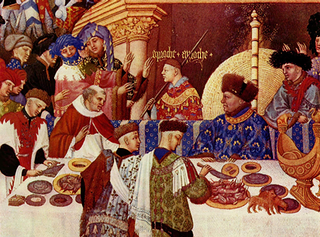You can eat a perfectly nutritious diet for a lot less money than the US government says you need. But would you want to?

Podcast: Play in new window | Download (Duration: 24:02 — 19.4MB)
Subscribe: Google Podcasts | Spotify | Android | | More
 Recently I’ve been involved in a couple of online discussions about the cost of a nutritious diet. The crucial issue is why poor people in rich countries seem to have such unhealthy diets. One argument is about the cost of food. Another is about everything other than cost: knowledge, equipment, time, conditions.
Recently I’ve been involved in a couple of online discussions about the cost of a nutritious diet. The crucial issue is why poor people in rich countries seem to have such unhealthy diets. One argument is about the cost of food. Another is about everything other than cost: knowledge, equipment, time, conditions.
My own opinion is that given all those other things, the externalities, a nutritious diet is actually not that expensive. But that’s just an opinion, so I went looking for information, and found it in a paper entitled Using the Thrifty Food Plan to Assess the Cost of a Nutritious Diet, published in the Journal of Consumer Affairs in 2009. The very first sentence of that paper is:
How much does a nutritious diet cost?
Parke Wilde, author of that paper, is an agricultural economist at the Friedman School of Nutrition Science and Policy at Tufts University in Boston, and I really enjoyed talking to him for the podcast.
Our discussion was limited to the United States and to the peculiarities of SNAP, but it is clear that other rich countries are also grappling with the difficulties of deciding what constitutes a nutritious diet and how to ensure that poor people can afford to eat it. Parke alluded to some of the crucial policy decisions, such as not allowing people to spend their SNAP benefits on things like alcohol while at the same time giving them the freedom to buy sugar-sweetened sodas if they so choose. There are incentives to buy healthier food, but even those come up against an important fact.
Unhealthy calories are much cheaper than healthy calories.
One study, which I found here, looked at exactly what you can buy for a dollar. If you’re looking for a snack, a dollar’s worth of cookies will buy you 1200 calories. The same dollar on carrots gets you only 250 calories. Thirsty? A dollar of orange juice is worth 170 calories, while a dollar of sugar-sweetened soda is 875 calories. Of course calories aren’t everything. But in the short term, if you’re hungry, calories are everything.
A different version of the same sort of story is the “healthy food is more expensive” trope, which crops up regularly. In the UK, a 2014 study claimed that on average 1000 calories of “healthy” food cost about 3 times more than 1000 calories of “unhealthy” food. This kind of study – and others like it – uses government agency definitions of healthy and unhealthy but doesn’t actually take nutrition into account. The cheapest category in that study was starchy carbohydrates – which the UK’s Food Standards Agency places just behind fruit and vegetables in terms of “healthiness”. You could eat a lot of “bread, rice, potatoes and pasta” for calories and a bit of fruit and vegetables for nutrients and end up with a pretty nutritious diet.
Would you want to, though?
That’s the crux of the matter. A nutritious diet can be had for reasonably little money (given that you know how to cook and have the facilities) but you might not enjoy it all that much.
Notes
- Using the Thrifty Food Plan to Assess the Cost of a Nutritious Diet
- If you really want to get some insight into the tricky triple balancing act of foods, nutrients and cash, Parke Wilde and his collaborators have made their model available for you to play with.
- Parke Wilde’s website. A really interesting recent piece of his looked at proposals to amend SNAP to restrict access to sugar-sweetened beverages.
- The USDA’s monthly Cost of Food reports are online
- The banner photograph is from Millie Copper who tried to buy a healthy diet based on the Thrifty Food Plan costs for a couple of weeks.
- Thanks to Christopher Gifford, a great Patreon, for inspiring this episode.
- Peel an onion, and stick five or six whole cloves in it. Put it in a saucepan with about 500 gm of brown or green lentils. Add a stock cube or a spoonful of miso paste if you have some, but if you haven’t, that’s OK. Cover with water and bring to a boil. Simmer for 30–45 minutes. Serve with lots of bread and a nice green salad.
 Huffduff it
Huffduff it
Eat This Newsletter 049 Authentic food news
Stimulation for mind and body; keeping harvests dry, making cacao harvest go further, coping with abundant harvests, the harvest of food anthropology, the biology of maca.
20 February 2017
- A lot of food “waste” is the result of poor after-harvest practices. A cheap, simple moisture meter could reduce losses.
- Despite the off-putting image of a jar of Nutella (do people really like it?) I enjoyed From Napoleon to Nutella: The Birth of the Chocolate-Hazelnut Spread. Also, it pointed me to the chocolate hazelnut history motherlode.
- How about the scarcity of scarcity? The End of Scarcity in Agricultural Commodities Means Failing Farms in the U.S.
- In addition to speaking to me last week, Rachel Laudan’s been thinking about Foodways and Ways of Talking about Food. Stimulating stuff.
- And talking of stimulating stuff, among the usual suspects of Valentine’s day coverage, only one is worth sharing here: the Botanist in the Kitchen on Maca. “Is it more than just an alpine turnip?”
Too hot to handle?
Here’s part of the pitch for Jeremy Parzen’s seminar in Food and Wine Journalism in Piedmont in the autumn.
Jeremy Parzen Will be teaching a seminar in Food and Wine Journalism in Piedmont in the autumn. Here’s part of the pitch:
The origins of pain, longing, and [mimetic] desire in food blogging today stretch back to early Greek tragedy and beyond. Yes, this trend in food writing today has also been molded by the rise of reality television. And yes, there are technical, societal, and cultural factors that have contributed to these phenomena as well.
But looking at these currents from an epistemological perspective, I ask myself: How did we get from Betty Crocker’s tips for grilling to Page Six stories about alcohol-fueled orgies at a celebrity chef’s Manhattan restaurant? What role does food culture and food writing play in our ethos — personal and national?
That’d be fun.
Food and status I'll have what their lordships are having
Food has always been a marker of social status, only today no elite eater worth their pink Himalayan salt would be seen dead with a slice of fluffy white bread, once the envy of the lower orders.

Podcast: Play in new window | Download (Duration: 19:56 — 16.6MB)
Subscribe: Google Podcasts | Spotify | Android | | More
 Food has probably been a marker of social status since the first woman gathered more berries than her sister. It still is. Some foods are authentically posh, others undeniably lower class, and there’s no way I’m going to go out on a limb and say which is which.
Food has probably been a marker of social status since the first woman gathered more berries than her sister. It still is. Some foods are authentically posh, others undeniably lower class, and there’s no way I’m going to go out on a limb and say which is which.
Because foods serve as social markers, the history of cuisine is also a history of the democratisation – some would say vulgarisation – of elite dishes, and perhaps noone has chronicled that more effectively than Rachel Laudan. Her book Cuisine and Empire: Cooking in World History shows clearly how foods move from high cuisine to low. Recently, in some places, the flow has reversed as elites have taken up what they imagine to be rustic, peasant food. The 100% wholewheat sourdough loaf, chewy of crust and riddled with large holes, became a desirable bread only very recently. As we chatted about these things, one thing became clear. There’s very little chance that food will lose its status as a marker of status any time soon.
 Huffduff it
Huffduff it
Notes
- Rachel Laudan recently reworked her thoughts on bread: Why did our ancestors prefer white bread to wholegrains?. That will take you to her website and details of Cuisine and Empire.
- Our earlier conversation was Sugar and salt: Industrial is best.
- Banner photo shows poor old George IV of the United Kingdom, consuming his magnificent Coronation Dinner alone, watched by a crowd of thousands. Well, not quite alone. Aside from the onlookers in the galleries, there were about 170 diners in Westminster Hall with him and a few hundred more scattered through various rooms in the Palace of Westminster. But the King was effectively alone.
- Smaller image shows John, Duc de Berry, in blue on the right, exchanging New Year’s gifts at a banquet.
Let them eat kale
People who don’t rely on supermarkets for their fresh produce seem to be doing fine.
The UK’s shortage of vegetables ((Which Modern Farmer helpfully extends to “vegetable-like fruits,” bless its cotton socks.)) remains in the news.
Meanwhile, people who don’t rely on supermarkets for their fresh produce seem to be doing fine, like my friend Dan, who sent this note.
Haven’t really even noticed the lettuce shortage. We eat Spanish broccoli, but mostly eat local, seasonal greens. Loads of kale, cavolo nero etc around here now, and cauliflower.
He also mentioned Claytonia perfoliata, aka miner’s lettuce and winter purslane. I’d forgotten about that, to be honest, though I used to grow it in the UK. Very good it is too.
There are, in fact, many more salad leaves than were pictured in the article in Eat This Newsletter and the current shortage ought to be a great incentive to try some of them. Instead, it seems to be bringing out the worst in at least one newspaper columnist.

 Recently I’ve been involved in a couple of online discussions about the cost of a nutritious diet. The crucial issue is why poor people in rich countries seem to have such unhealthy diets. One argument is about the cost of food. Another is about everything other than cost: knowledge, equipment, time, conditions.
Recently I’ve been involved in a couple of online discussions about the cost of a nutritious diet. The crucial issue is why poor people in rich countries seem to have such unhealthy diets. One argument is about the cost of food. Another is about everything other than cost: knowledge, equipment, time, conditions.

 Food has probably been a marker of social status since the first woman gathered more berries than her sister. It still is. Some foods are authentically posh, others undeniably lower class, and there’s no way I’m going to go out on a limb and say which is which.
Food has probably been a marker of social status since the first woman gathered more berries than her sister. It still is. Some foods are authentically posh, others undeniably lower class, and there’s no way I’m going to go out on a limb and say which is which.